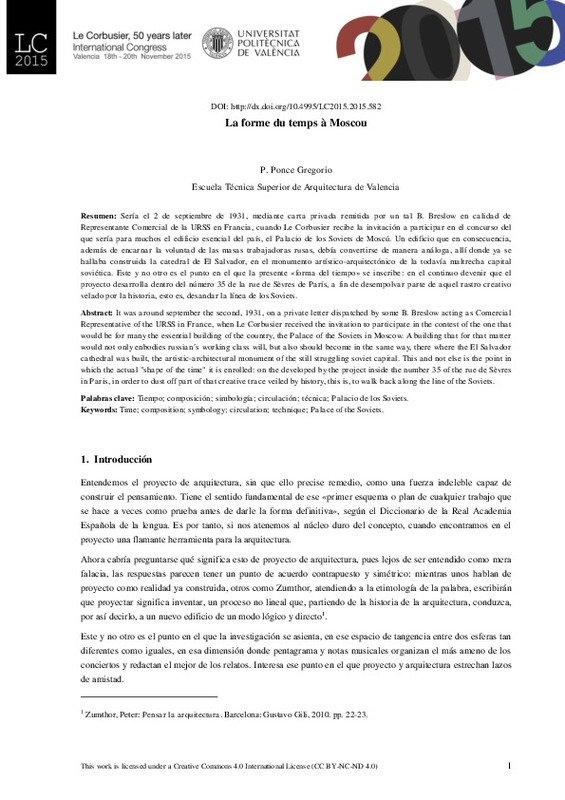JavaScript is disabled for your browser. Some features of this site may not work without it.
Buscar en RiuNet
Listar
Mi cuenta
Estadísticas
Ayuda RiuNet
Admin. UPV
La forme du temps à Moscou
Mostrar el registro sencillo del ítem
Ficheros en el ítem
| dc.contributor.author | Ponce Gregorio, Pedro
|
es_ES |
| dc.date.accessioned | 2018-02-09T07:53:51Z | |
| dc.date.available | 2018-02-09T07:53:51Z | |
| dc.date.issued | 2016-03-03 | |
| dc.identifier.isbn | 9788490483732 | |
| dc.identifier.uri | http://hdl.handle.net/10251/97547 | |
| dc.description.abstract | [EN] It was around september the second, 1931, on a private letter dispatched by some B. Breslow acting as Comercial Representative of the URSS in France, when Le Corbusier received the invitation to participate in the contest of the one that would be for many the essential building of the country, the Palace of the Soviets in Moscow. A building that for that matter would not only enbodies russian´s working class will, but also should become in the same way, there where the El Salvador cathedral was built, the artistic-architectural monument of the still struggling soviet capital. This and not else is the point in which the actual "shape of the time" it is enrolled: on the developed by the project inside the number 35 of the rue de Sèvres in Paris, in order to dust off part of that creative trace veiled by history, this is, to walk back along the line of the Soviets. | es_ES |
| dc.description.abstract | [ES] Sería el 2 de septiembre de 1931, mediante carta privada remitida por un tal B. Breslow en calidad de Representante Comercial de la URSS en Francia, cuando Le Corbusier recibe la invitación a participar en el concurso del que sería para muchos el edificio esencial del país, el Palacio de los Soviets de Moscú. Un edificio que en consecuencia, además de encarnar la voluntad de las masas trabajadoras rusas, debía convertirse de manera análoga, allí donde ya se hallaba construida la catedral de El Salvador, en el monumento artístico-arquitectónico de la todavía maltrecha capital soviética. Este y no otro es el punto en el que la presente «forma del tiempo» se inscribe: en el continuo devenir que el proyecto desarrolla dentro del número 35 de la rue de Sèvres de París, a fin de desempolvar parte de aquel rastro creativo velado por la historia, esto es, desandar la línea de los Soviets. | es_ES |
| dc.format.extent | 21 | es_ES |
| dc.language | Español | es_ES |
| dc.publisher | Editorial Universitat Politècnica de València | es_ES |
| dc.relation.ispartof | LE CORBUSIER. 50 AÑOS DESPUÉS | es_ES |
| dc.rights | Reconocimiento - No comercial - Sin obra derivada (by-nc-nd) | es_ES |
| dc.subject | Architecture | es_ES |
| dc.subject | Le Corbusier | es_ES |
| dc.subject | Modern movement | es_ES |
| dc.subject | Tiempo | es_ES |
| dc.subject | Composición | es_ES |
| dc.subject | Simbología | es_ES |
| dc.subject | Circulación | es_ES |
| dc.subject | Técnica | es_ES |
| dc.subject | Palacio de los Soviets | es_ES |
| dc.title | La forme du temps à Moscou | es_ES |
| dc.type | Capítulo de libro | es_ES |
| dc.type | Comunicación en congreso | es_ES |
| dc.identifier.doi | 10.4995/LC2015.2015.582 | |
| dc.rights.accessRights | Abierto | es_ES |
| dc.contributor.affiliation | Universitat Politècnica de València. Departamento de Proyectos Arquitectónicos - Departament de Projectes Arquitectònics | es_ES |
| dc.description.bibliographicCitation | Ponce Gregorio, P. (2016). La forme du temps à Moscou. En LE CORBUSIER. 50 AÑOS DESPUÉS. Editorial Universitat Politècnica de València. 1703-1724. https://doi.org/10.4995/LC2015.2015.582 | es_ES |
| dc.description.accrualMethod | OCS | es_ES |
| dc.relation.conferencename | LC2015 - Le Corbusier, 50 years later | es_ES |
| dc.relation.conferencedate | November 18-20,2015 | es_ES |
| dc.relation.conferenceplace | Valencia, Spain | es_ES |
| dc.relation.publisherversion | http://ocs.editorial.upv.es/index.php/LC2015/LC2015/paper/view/582 | es_ES |
| dc.description.upvformatpinicio | 1703 | es_ES |
| dc.description.upvformatpfin | 1724 | es_ES |
| dc.type.version | info:eu-repo/semantics/publishedVersion | es_ES |
| dc.relation.pasarela | OCS\582 | es_ES |








